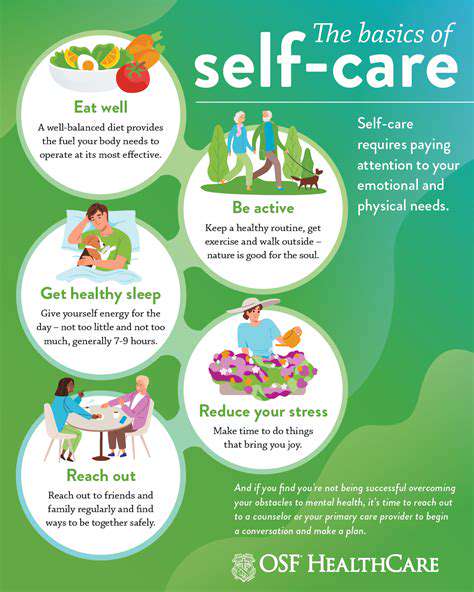Guide to Practicing Self Care Regularly

Understanding the Importance of Self-Care
Contrary to popular belief, self-care isn't just about indulgence—it's a fundamental practice for sustaining wellness. When you actively nurture your body, emotions, and mind, you cultivate the resilience needed to thrive in daily life. The consequences of ignoring these needs manifest gradually—diminished focus, emotional volatility, and even physical ailments often emerge as warning signs. Making self-care a priority isn't selfish; it's how we maintain our capacity to care for others.
How do you know when you're neglecting yourself? The body speaks through persistent fatigue, shortened temper, or that nagging sense of drowning in responsibilities. These aren't character flaws but biological distress signals. Chronic disregard can erode both health and happiness over time, making early intervention crucial.
Identifying Physical Self-Care Needs
Physical vitality forms the bedrock of personal wellness. Three pillars—restorative sleep, balanced nutrition, and consistent movement—work synergistically to optimize bodily functions. Small adjustments here yield disproportionate benefits: better concentration, emotional stability, and immune resilience. Your body communicates its needs through hunger cues, energy dips, and muscle tension—learning this language is half the battle.
Movement doesn't require marathon training. A 10-minute walk after meals, desk stretches during work breaks, or dancing while cooking all count. Nutritionally, focus on adding nourishing foods rather than restrictive dieting. Hydration deserves special attention—many fatigue complaints vanish with proper water intake.
Addressing Emotional Self-Care Needs
Emotional wellness requires attending to your inner landscape with curiosity rather than judgment. The healthiest individuals don't avoid negative emotions—they've developed constructive ways to process them. Techniques vary widely: some find clarity through morning pages journaling, others through forest bathing or therapy sessions. The common thread is creating space for emotional digestion.
Relationships function as emotional mirrors. Surround yourself with people who energize rather than deplete you. Practice saying no to preserve emotional reserves—it's not rejection but self-preservation. Remember that vulnerability with trusted individuals often strengthens bonds more than perpetual stoicism.
Prioritizing Mental Self-Care Needs
Cognitive wellness thrives on stimulation and rest in equal measure. Alternating between focused work and deliberate mental breaks prevents burnout. The Pomodoro Technique—25 minutes of concentration followed by 5-minute breaks—exemplifies this rhythm. Hobbies serve dual purposes: they're both stress relievers and neural fertilizer.
Digital detoxes are modern mental hygiene. Scheduled screen-free hours, especially before bedtime, improve sleep quality and reduce anxiety. For knowledge workers, engaging with completely unrelated subjects (like learning guitar chords or studying astronomy) creates valuable cognitive cross-training.
Creating a Self-Care Routine
Effective routines emerge from personal experimentation, not rigid templates. Start by auditing your weekly schedule for lost time—those fragmented 15-minute intervals perfect for micro self-care. Maybe it's brewing tea mindfully instead of gulping coffee, or doing sun salutations during morning news. Anchor new habits to existing ones (post-toothbrush meditation) for better adherence.
Track what works in a self-care journal. Note energy levels, mood patterns, and productivity peaks. After a month, you'll identify which practices deliver disproportionate benefits. Remember that consistency beats intensity—five minutes of daily breathing exercises outweighs an hour done sporadically.
Assessing and Adjusting Your Self-Care Plan
Wellness isn't static—your self-care plan shouldn't be either. Conduct quarterly life audits: Has your work schedule changed? Entered a new relationship phase? Developed health concerns? These all warrant plan adjustments. Sometimes self-care means swapping yoga for physical therapy, or book club for financial planning sessions.
The most sophisticated self-care plans include emergency protocols—pre-determined responses for high-stress periods. Maybe it's calling your sister when overwhelmed, or taking a mental health day when certain symptoms appear. Having these plans ready prevents decision fatigue during crises.
Crafting a Personalized Self-Care Routine: Tailoring it to Your Lifestyle

Understanding Your Needs
Effective self-care begins with forensic self-knowledge—what truly replenishes you might surprise you. Some recharge through social connection, others through solitude. Track your energy fluctuations for a week: when do you feel most vital? What activities create lingering positivity? The best self-care aligns with your chronotype, values, and current life season.
Create an energy map—list activities as energy givers or drainers. Be brutally honest. That book club you attend out of obligation? Probably a drain. Gardening despite the mess? Likely a giver. This exercise reveals where to invest your limited self-care time.
Creating a Sustainable Routine
Integration beats addition. Instead of carving out new time, enhance existing routines: practice gratitude during your commute, or do calf raises while brushing teeth. The magic happens when self-care becomes woven into daily living rather than an extra task. For parents, this might mean involving kids in kitchen yoga rather than waiting for alone time.
Build flexibility into your system. Have tiered self-care options: ideal (90-minute massage), good (15-minute foam rolling), and minimum viable (3-minute neck stretches). This ensures maintenance even on chaotic days. Remember that self-care includes saying not today to non-essentials—protecting time is self-care too.
Assemble a self-care menu with options for different needs: energizing (jump rope), calming (coloring books), social (call a friend), and intellectual (podcast). When depleted, consult the menu rather than defaulting to passive scrolling. This bridges the intention-action gap when willpower is low.




![Best Smart Light Bulbs [Review]](/static/images/31/2025-05/KeyFeaturestoConsiderWhenChoosingSmartBulbs.jpg)

![Best Smart Vacuum Cleaners [2025 Review]](/static/images/31/2025-05/SmartFeaturesandConnectivity3AStreamliningYourCleaningRoutine.jpg)




